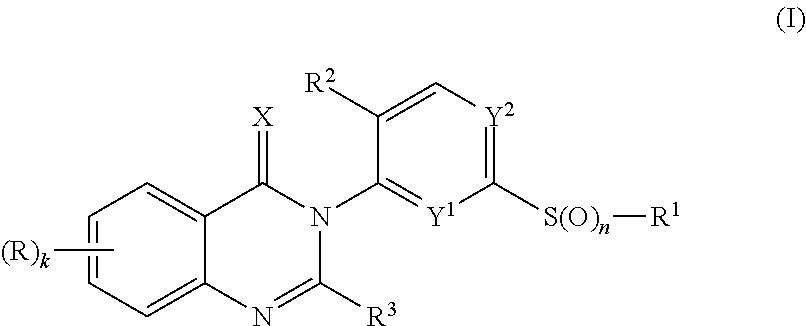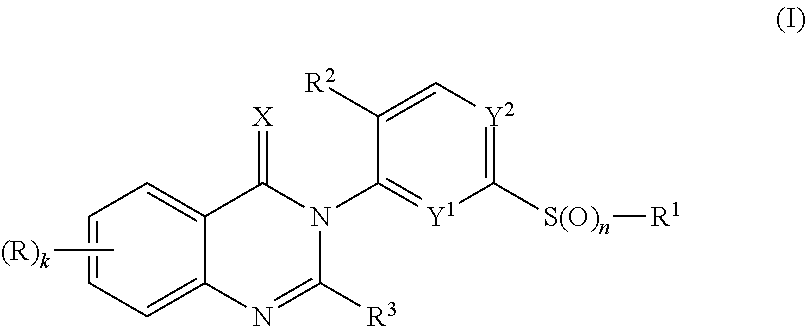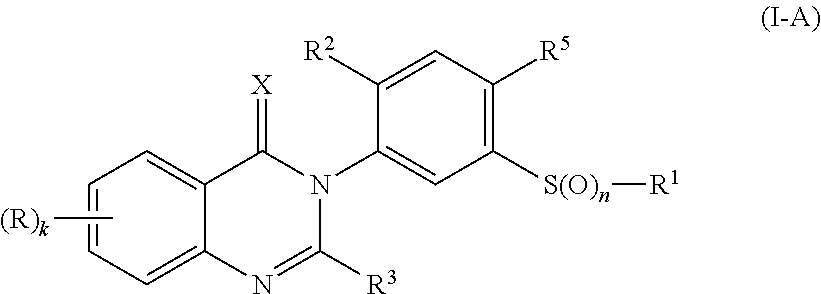3-Arylquinazolin-4-one compounds for combating invertebrate pests
a technology of invertebrate pests and compounds, which is applied in the direction of antiparasitic agents, biocides, drug compositions, etc., can solve the problems of large economic losses to food supply and property, and the pesticidal activities of prior art compounds, in particular their activities against arachnids such as mites, are not always satisfactory
- Summary
- Abstract
- Description
- Claims
- Application Information
AI Technical Summary
Benefits of technology
Problems solved by technology
Method used
Image
Examples
preparation examples
I. PREPARATION EXAMPLES
[0496]Products were characterized by 1H-NMR spectroscopy or HPLC (High Performance Liquid Chromatography Mass Spectrometry). HPLC was carried out using an analytic RP-18 column (Chromolith Speed ROD from Merck KGaA, Germany) which was operated at 40° C. Acetonitrile with 0.1% by volume of a trifluoro acetic acid / water mixture and 0.1% by volume of trifluoroacetic acid served as mobile phase; flow rate: 1.8 mL / min and injection volume: 2 μl.
example 1 (
Compound I-1)
2-(2,2,2-trifluoroethylsufanyl)-4-(4-oxo-quinazolin-3-yl)-5-fluoro-toluol
[0497](Compound of formula I, wherein k is 0, n is 0, R1 is F3C—CH2, R2 is F, R3 is H, Y1 is CH, Y2 is C—CH3 and X is O)
1.1 3-Acetamino-4-fluoro-6-methyl-phenylsulfonylchloride
[0498]To a solution of 2-fluoro-4-methyl-aniline (250 g, 2 mol) and triethylamine (202 g, 2 mol) in 2 L of dichloromethane was added dropwise acetylchloride (156 g, 2 mol). The reaction mixture was stirred for 2 hours at a temperature of 0° C. and subsequently washed with dilute hydrochloric acid. The organic phase was dried with sodium sulfate and concentrated under reduced pressure to yield 2-fluoro-4-methyl-acetanilide as a crude intermediate (334 g, 87%).
[0499]To 546 g (3.27 mol) of crude 2-fluoro-4-methyl-acetanilide was added chlorosulphonic acid (2000 g, 17.24 mol) with stirring at a temperature below 70° C. Stirring was continued for 3 hours at a temperature of 70° C. The reaction mixture was poured onto ice and then ...
example 2 (
Compound I-2)
2-(2,2,2-trifluoroethylsufinyl)-4-(4-oxo-quinazolin-3-yl)-5-fluoro-toluol
[0513](Compound of formula I, wherein k is 0, n is 1, R1 is F3C—CH2, R2 is F, R3 is H, Y1 is CH, Y2 is C—CH3 and X is O)
[0514]2-(2,2,2-Trifluoroethylsulfanyl)-4-(4-oxo-quinazolin-3-yl)-5-fluoro-toluol (0.80 g, 1.96 mmol) was dissolved in 20 mL chloroform and meta-chloroperoxybenzoic acid (0.466 g, 2.29 mmol, 85% of purity) was added under ice-cooling. The reaction mixture was stirred for 1 hour at ice bath temperature. The solution was washed successively with an aqueous solution of sodiumthiosulfate and an aqueous solution of sodiumhydrogencarbonate, and dried with sodium sulfate. After removing excess solvent under reduced pressure the crude product was purified by column chromatography on silica gel to give the title compound (0.32 g, 42.9%) as an off-white solid.
[0515]1H NMR (400 MHz, CDCl3): δ=8.34-8.36 (m, 1H), 8.08 (d, 1H, J=7.2 Hz), 8.02 (s, 1H), 7.48-7.53 (m, 2H), 7.79-7.87 (m, 2H), 7.56-7...
PUM
| Property | Measurement | Unit |
|---|---|---|
| Mass | aaaaa | aaaaa |
| Mass | aaaaa | aaaaa |
| Fraction | aaaaa | aaaaa |
Abstract
Description
Claims
Application Information
 Login to View More
Login to View More - R&D
- Intellectual Property
- Life Sciences
- Materials
- Tech Scout
- Unparalleled Data Quality
- Higher Quality Content
- 60% Fewer Hallucinations
Browse by: Latest US Patents, China's latest patents, Technical Efficacy Thesaurus, Application Domain, Technology Topic, Popular Technical Reports.
© 2025 PatSnap. All rights reserved.Legal|Privacy policy|Modern Slavery Act Transparency Statement|Sitemap|About US| Contact US: help@patsnap.com



